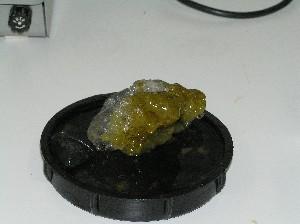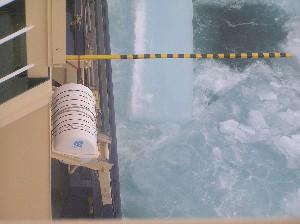
|
|
13 August, 2004
Ice, ice and more ice!
It is hard to believe we were taking photos of small ice floes a
couple of days ago. Now we are in much thicker ice and the icebreakers are
hard at work. The Sovetskiy leads the way, breaking the heavier ice and we
follow behind on the Oden, following in the path of the Russian ship except
where blocks of ice must be broken and crushed further. The Viking trails
close behind us. When we have better weather for the helicopters to fly ice
reconnaissance there will be some wonderful photos, I'm sure, of the 3 ships
in a line. For now we are experiencing the typical Arctic fog. The ice is
hardest to break through when we try to cross through an ice pressure ridge;
these ridges are formed when wind pushes two ice floes together, actually
pushing the ice up into a raised ridge. From a distance some of these
pressure ridges look like ice "dunes". At times one of the ships will get
slightly stuck and will have to do some maneuvering to break free. The Oden
will release powerful jets of water out of the bow and side hulls to
lubricate the hull and make it easier to slide past the ice. Other times we
rock gently back and forth to release the ship. There are some very weird
and eerie noises as we scrape past larger pieces of ice and I try to record
these sounds on audio tape. As interesting as they are to listen to in the
daytime, they are quite a different thing when you are trying to sleep at
night.
I have a lesson in measuring ice thickness from Roger Pilkington of the Ice
Management Team on the bridge. There is a rod suspended perpendicular from
the side of the ship that is calibrated in 20cm increments. If you look down
upon the rod from above, say from the bridge, you can watch as a piece of
ice rolls over on its side from the force of icebreaking. By taking a photo
of the ice passing under this rod, you can determine its depth. I use this
method and determine the ice to be about 2.2 meters thick.
The Weather Team is also operating on the bridge. Lately I am
gathering location information (latitude/longitude) as well as weather data
each day so that I can use it in lessons when I return to the Narragansett
Pier Middle School. Meteorologist Sandy Olsson has shown me how the data is
gathered from the various meteorological instruments and then entered onto a
log sheet. Today he allows me to fill in the official Oden Weather Log - I
am the recording meteorologist for this watch!
I get a call on my official mobile phone from Henk Brinkhuis, a
micropaleontologist, asking if I'd like to come down to the main lab to see
what's happening. Moving down from the 6th deck to the first, I visit the
lab where the microbiologist and micropaleontologists are setting up their
lab equipment. The Oden had stopped for a short time, most likely for a
helicopter transfer, and some of the scientists scooped up some surface ice
to examine for microorganisms. After melting the ice, and sieving it through
a 20 micron filter, they are examining the slides under the microscope. How
exciting to be looking at diatoms direct from arctic sea ice. I am talking
with the Japanese micropaleontologists, who are making prepared slides and
I'm hopeful that maybe I can bring back some slides of these ice algae from
870 N.

Sea ice with algae from 87 degrees North

Measuring sea ice from the bridge of the Oden
Contact the TEA in the field at
.
If you cannot connect through your browser, copy the
TEA's e-mail address in the "To:" line of
your favorite e-mail package.
|
